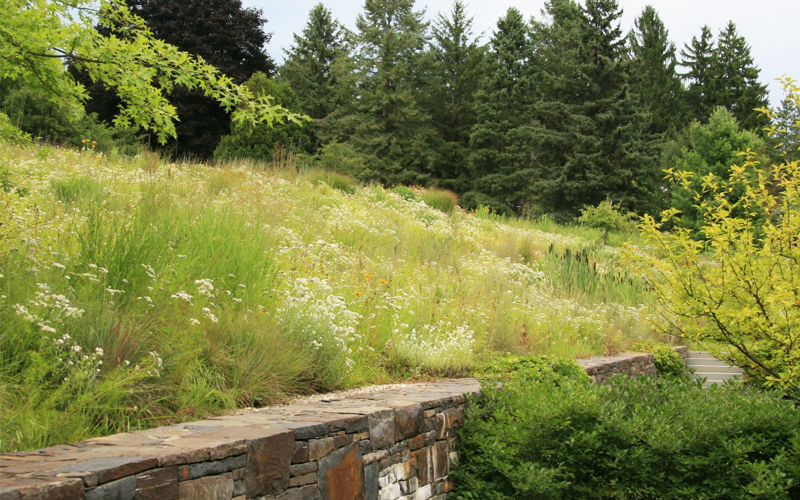Professional Practice
Applying Ecological Design: Native Plants
 A meadow on a lakeside property in Lakeville, Connecticut / Larry Weaner Landscape Associates with Jaime Purinton Landscape Architect
A meadow on a lakeside property in Lakeville, Connecticut / Larry Weaner Landscape Associates with Jaime Purinton Landscape ArchitectNative plants offer aesthetic and ecological benefits for residential landscapes. They are crucial to restoring local ecosystems, increase biodiversity, and provide ideal habitat for wildlife. Due to their hardiness and high resistance, native plants can effectively filter stormwater and greywater. And once established, native plants are low maintenance and require minimal irrigation.
Using native plants can help achieve credit for soil and vegetation. By using native vegetation that contributes to the siteˇŻs eco-region, homeowners can minimize damage to healthy plant communities while restoring diminished plant communities. In addition to their inherent environmental benefits, native plants reduce the need to use pesticides, which runoff into water supplies, and equipment that release a range of pollutants and can cumulatively affect air quality.
Native plant benefits include:
- Reduced environmental contamination: Native plants reduce the need to use chemical fertilizers, pesticides and other toxic lawn maintenance treatments.
- Increased water quality: Native plants filter stormwater and greywater
- Improved air quality: Landscape maintenance equipment produces up to five percent of ozone-forming volatile organic chemicals (VOCs) and can also emit toxic particulates.
- Due to the inherent low maintenance nature of native plants, the need for mowing and other conventional maintenance equipment can be eliminated.
There are a variety of plants native to different regions, and selection depends on local soil type and site conditions. Many localities around the world fund registries of local native plants; check with native plant societies and nurseries. Governments also support the planting of native species. In 2016, the Washington, D.C. department of energy and the environment handed out 8,000 packets of at metro stop throughout the city.
At the neighborhood scale, multiple residents using native plants on their property can help to build a network that supports biodiversity, pollinator health, and ecological restoration. Integrating more native plants into back and front yards, as well as streetscapes and parks, creates more opportunities for local insects, including pollinators, and birds to move across the landscape.
Sources: , U.S. Environmental Protection Agency; , Mark McDonnell, Amy Hahs, The Nature of Cities
Organizations
Note: Most U.S. states and countries have native plant societies. These are just a few examples. The American Horticultural Society has by state.
Resources
, Lady Bird Johnson Wildflower Center
, NC State University
, Adkins Arboretum
, BBC News
, National Wildlife Federation
, Audubon
, Missouri Botanical Garden
, Seattle Public Utilities
, Australian Outdoor Living
Research
ˇ°,ˇ± Thomas Rainer and Claudia West, Timber Press, 2015
ˇ°,ˇ± Larry Weaner and Thomas Christopher, Timber Press, 2016
ˇ°,ˇ± Travis Beck, Island Press, 2013
ˇ°,ˇ± Rick Darke and Douglas W. Tallamy, Timber Press, 2014
ˇ°,ˇ± Douglas W. Tallamy and Rick Darke, Timber Press, 2009
"," C. Colston Burrell. Brooklyn Botanic Garden, 2006
"," William Cullina. Houghton Mifflin Harcourt, 2008
Government Resources
, Environmental Protection Agency
, University of Florida Levin College of Law
, Fairfax County, Virginia
, City of Portland, Oregon
, Department of Energy & Environment, DC
, National Landscape Conservation System, Bureau of Land Management, U.S. Department of the Interior
, Department of Conservation and Natural Resources, State of Pennsylvania
, Department of Conservation & Recreation, State of Virginia
Projects
Flying Point Residence, Southampton, New York
Edmund Hollander Landscape Architect Design
Water Calculation and Poetic Interpretation, Monterey Cypress, California
Arterra Landscape Architects
West Texas Ranch, Marfa, Texas
Ten Eyck Landscape Architects, Inc.
Maple Hill Residence, Westwood Massachusetts
Stephen Stimson Associates Landscape Architects
Farrar Pont Residence, Lincoln, Massachusetts
Mikyoung Kim Design, Brookline, Massachusetts
Ketchum Residence, Ketchum, Idaho
Lutsko Associates
Lee Landscape, Calistoga, California
Blasen Landscape Architecture, San Anselmo, California
Pump House, Highland Park, Texas
MESA, Dallas, Texas and D.I.R.T. Studio, Charlottesville, Virginia
San Juan Island Residence, San Juan Islands, Washington
Paul Broadhurst & Associates, Seattle, Washington